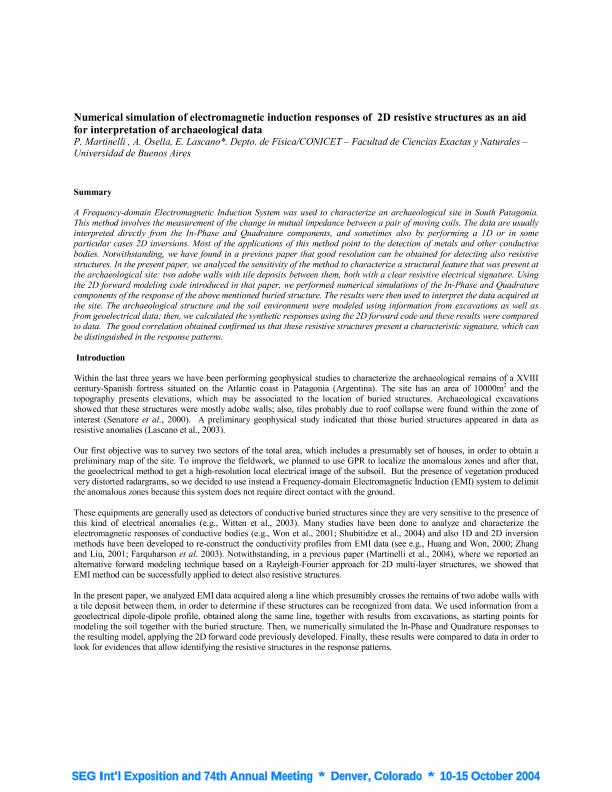Mostrar el registro sencillo del ítem
dc.contributor.author
Martinelli, Hilda Patricia

dc.contributor.author
Osella, Ana Maria

dc.contributor.author
Lascano, Eugenia
dc.date.available
2019-04-12T14:01:44Z
dc.date.issued
2004-12
dc.identifier.citation
Martinelli, Hilda Patricia; Osella, Ana Maria; Lascano, Eugenia; Numerical simulation of electromagnetic induction responses of 2D resistive structures as an aid for interpretation of archaeological data; Society of Exploration Geophysicists; SEG Technical Program Expanded Abstracts; 23; 1; 12-2004; 1456-1459
dc.identifier.issn
1949-4645
dc.identifier.uri
http://hdl.handle.net/11336/74194
dc.description.abstract
A Frequency-domain Electromagnetic Induction System was used to characterize an archaeological site in South Patagonia. This method involves the measurement of the change in mutual impedance between a pair of moving coils. The data are usually interpreted directly from the In-Phase and Quadrature components, and sometimes also by performing a 1D or in some particular cases 2D inversions. Most of the applications of this method point to the detection of metals and other conductive bodies. Notwithstanding, we have found in a previous paper that good resolution can be obtained for detecting also resistive structures. In the present paper, we analyzed the sensitivity of the method to characterize a structural feature that was present at the archaeological site: two adobe walls with tile deposits between them, both with a clear resistive electrical signature. Using the 2D forward modeling code introduced in that paper, we performed numerical simulations of the In-Phase and Quadrature components of the response of the above mentioned buried structure. The results were then used to interpret the data acquired at the site. The archaeological structure and the soil environment were modeled using information from excavations as well as from geoelectrical data; then, we calculated the synthetic responses using the 2D forward code and these results were compared to data. The good correlation obtained confirmed us that these resistive structures present a characteristic signature, which can be distinguished in the response patterns.
dc.format
application/pdf
dc.language.iso
eng
dc.publisher
Society of Exploration Geophysicists
dc.rights
info:eu-repo/semantics/openAccess
dc.rights.uri
https://creativecommons.org/licenses/by-nc-sa/2.5/ar/
dc.subject
Electromagnetic Induction
dc.subject
Gem-2
dc.subject
Numerical Simulation
dc.subject
Archaeo-Geophysics
dc.subject.classification
Meteorología y Ciencias Atmosféricas

dc.subject.classification
Ciencias de la Tierra y relacionadas con el Medio Ambiente

dc.subject.classification
CIENCIAS NATURALES Y EXACTAS

dc.title
Numerical simulation of electromagnetic induction responses of 2D resistive structures as an aid for interpretation of archaeological data
dc.type
info:eu-repo/semantics/article
dc.type
info:ar-repo/semantics/artículo
dc.type
info:eu-repo/semantics/publishedVersion
dc.date.updated
2019-04-05T18:26:08Z
dc.journal.volume
23
dc.journal.number
1
dc.journal.pagination
1456-1459
dc.journal.pais
Estados Unidos

dc.journal.ciudad
Nueva York
dc.description.fil
Fil: Martinelli, Hilda Patricia. Consejo Nacional de Investigaciones Científicas y Técnicas. Oficina de Coordinación Administrativa Ciudad Universitaria. Instituto de Física de Buenos Aires. Universidad de Buenos Aires. Facultad de Ciencias Exactas y Naturales. Instituto de Física de Buenos Aires; Argentina
dc.description.fil
Fil: Osella, Ana Maria. Consejo Nacional de Investigaciones Científicas y Técnicas. Oficina de Coordinación Administrativa Ciudad Universitaria. Instituto de Física de Buenos Aires. Universidad de Buenos Aires. Facultad de Ciencias Exactas y Naturales. Instituto de Física de Buenos Aires; Argentina
dc.description.fil
Fil: Lascano, Eugenia. Consejo Nacional de Investigaciones Científicas y Técnicas. Oficina de Coordinación Administrativa Ciudad Universitaria. Instituto de Física de Buenos Aires. Universidad de Buenos Aires. Facultad de Ciencias Exactas y Naturales. Instituto de Física de Buenos Aires; Argentina
dc.journal.title
SEG Technical Program Expanded Abstracts
dc.relation.alternativeid
info:eu-repo/semantics/altIdentifier/doi/http://dx.doi.org/10.1190/1.1845126
Archivos asociados
